Pondering Ann Arbor Poll Accessibility
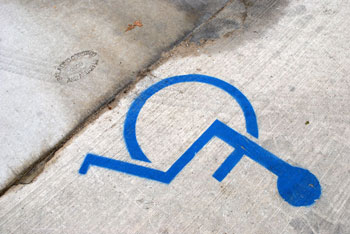
University Townhouses, the polling location for Precinct 5 in Ward 3, had specific improvements made under a 2005 grant. (Photo by the writer on Sept. 7, 2009; links to higher resolution file.)
In a letter dated Sept. 1, 2009, addressed to Ann Arbor’s city clerk, Jackie Beaudry, the nonprofit Michigan Protection & Advocacy Service Inc. gave the city a Sept. 15 deadline to respond to its concerns about accessibility to polling locations in Ann Arbor.
The response deadline comes two weeks ahead of the expiration of a grant for which the city was approved in 2007 under the Help America Vote Act (HAVA). The grant was for improvements in accessibility to Tappan and Eberwhite schools.
Lansing-based MPAS is concerned that the city has not submitted work for reimbursement under the 2007 grant. And that would put in jeopardy the city’s 2009 grant application for improvements to five additional locations – Northside, Dicken, Lawton, Lakewood and Pittsfield elementary schools. The MPAS letter paints a picture suggesting the city has not made progress towards addressing problems that the city itself identified in 2004 at 21 of the city’s 48 precincts.
However, after checking into the matter with MPAS, the state’s Bureau of Elections, and Ann Arbor city staff, The Chronicle has concluded that: (i) the situation with the 2007 grant is a matter of non-communication and paperwork follow-through, (ii) that prior to 2007, the city of Ann Arbor completed work under HAVA grants, with some reimbursements already made, and other payments still in process, and (iii) the city’s strategy for ensuring access uses a variety of temporary measures on election days, as well as a work plan for more permanent fixes.
Where The Chronicle Started
The letter from MPAS cites 2005 as the year when the city of Ann Arbor identified polling places in need of accessibility improvements. A phone call to MPAS pointed us to a 2005 HAVA grant award for specific improvements to be made at three different polling places: University Townhouses (Ward 3), Ann Arbor Community Center (Ward 1) and the Second Baptist Church (Ward 5).
If MPAS was contending that 2007 grant money hadn’t been used, we wondered: What about the 2005 grant? So we began with those 2005 locations.
We had recent familiarity with those places. The Chronicle had toured all polling locations in Wards 3 and 5 during the Aug. 4, 2009 Democratic primary elections – which included the Second Baptist Church and University Townhouses. The Chronicle also covered the city Democratic party candidate forums held at the Ann Arbor Community Center.
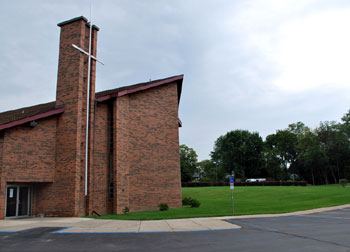
Second Baptist Church in Ward 5 (Photo by the writer on Sept. 7, 2009; links to higher resolution file.)
It had been our recollection that those three locations had some kind of ramps and signage – but it takes more than some ramp or sign to meet accessibility requirements. So we elected to return to those locations as part of this report to document photographically their outside entrances. The Ann Arbor Community Center didn’t appear to have had any work done recently. But the Second Baptist Church and University Townhouses showed signs of having recent work completed.
Was it enough to make the locations accessible? Had the city of Ann Arbor sought and received reimbursement? If so, was MPAS aware of the city’s past HAVA record?
First, though, what is the Michigan Protection & Advocacy Service and the Help America Vote Act?
Background on MPAS and HAVA
The outcome of the Gore versus Bush 2000 presidential election was controversial – due to how ballots were counted and evaluated initially and during recounts. At least partly in response to that controversy, the Help America Vote Act was passed in 2002. Goals of that legislation included improvements in voting systems (how voters actually indicate their vote) and the overall administration of elections.
As a part of that act, funds were made available for improvements not just in voting equipment, but also to make improvements in the accessibility of polling places. In Michigan those federal funds are provided in the form of grants awarded and administered by the state Bureau of Elections. The award of a grant does not mean that funds are transferred – the work must be completed and paid for, and is then reimbursed.
Physical access to polling sites is supported by federal laws: the Voting Accessibility for the Elderly and Handicapped Act (VAEHA) of 1984, as well as the Americans with Disabilities Act, which requires access to places of public accomodation. The ADA requires removal of architectural barriers to the extent that such removal is readily achievable, but the act does not require structural changes if other methods can accomplish the same goal.
Where does the Michigan Protection & Advocacy Service fit in? MPAS is an entity designated by the governor to advocate for people with disabilities. And with respect to HAVA grants, MPAS verifies that the polling places identified by a municipality are, in fact, currently deficient. A HAVA grant award is made to a municipality based on a recommendation from MPAS.
That’s what happened in 2005 when Ann Arbor was awarded $16,750 that it could claim in reimbursements. In the press release from Sept. 30, 2005, issued by the state Bureau of Elections, Beaudry is quoted as saying, “The polling place improvements made as a result of this grant award will provide for greater independent access to the precincts and the voting process for all residents of the city of Ann Arbor.”
Improvements at Ann Arbor Polling Places
-
2005
Returning to the apparent improvements that The Chronicle had noticed at the Second Baptist Church and University Townhouses: Was any of the 2005 HAVA grant money spent on those projects?
According to the state Bureau of Elections, out of the $16,750 awarded that year, $4,450 was paid. The rest of these funds were canceled and a new application processed. Those remaining funds would have gone to reimburse work at the Ann Arbor Community Center – but around that time, in the summer of 2006, the future use of AACC as a polling place was uncertain. The center faced a financial crisis described in a June 28, 2006 Ann Arbor News article [this link goes to the Ann Arbor District Library archive, which requires free registration]. The article states:
Barring a major infusion of cash, the center at 625 N. Main St., which specializes in serving the black community, had faced the possibility of closing Friday. But in an emergency meeting Tuesday, its governing board set up a plan for the center to operate with limited hours starting next week.
On the phone this week with The Chronicle, city clerk Jackie Beaudry recalled how in November of 2006, Precinct 4 in Ward 1 had moved its polling place to Community High School, doubling up with Precinct 3. Given the uncertainty of the center’s future, Beaudry said, the grant application was withdrawn. Reapplication would be made in 2007.
2006
In the 2006 HAVA grant cycle, Ann Arbor was awarded $15,300, with $2,400 paid to date. According to the city of Ann Arbor, and confirmed by the state Bureau of Elections, that grant was for work at King, Tappan, and Eberwhite elementary schools. The work at King was completed, but extensions were requested for Tappan and Eberwhite to the summer of 2009.
According to Beaudry, the work for Tappan and Eberwhite was completed by the Ann Arbor Public Schools in the summer of 2009. We can lend partial support to that contention, based just on our Aug. 4, 2009 primary elelection report, for which we toured all the precinct locations:
3:05 p.m. Ward 5. Eberwhite Elementary. Lots of construction around the school. Sidewalk repairs and whatnot. Ann Arbor Public Schools seems to have a capital maintenance program running up til the opening of school session.
It’s the fact that the Tappan and Eberwhite grants are still open that eventually led to the current focus and scrutiny by MPAS. The Sept. 30 deadline in the MPAS letter comes from the Bureau of Elections, which wrote in an email to The Chronicle: “We are waiting to hear what they [the city of Ann Arbor] want to do with this money prior to September 30, 2009.”
2007-2009
In October 2007, with the Tappan and Eberwhite grants still open, Ann Arbor applied for three additional grants:
- Slauson Middle School (elevator, parking)
- Clague Middle School (exterior ramps)
- Ann Arbor Community Center (reapplication for parking, sidewalk, door and vestibule)
But according to Wendy Rampson, who’s head of planning and development with the city, Ann Arbor didn’t receive any official notification about those applications from the Bureau of Elections.
So in May 2009, city staff requested official responses on the 2007 applications. There’s been no response from the BOE to date, according to Rampson. Also in May 2009, the city applied for five additional grants, and has not yet received official notification from the BOE:
- Dicken School (parking, thresholds)
- Lakewood School (thresholds)
- Lawton School (parking, thresholds)
- Northside School (parking)
- Pittsfield School (thresholds, vestibule)
Open Grants: Source of Friction
Because the Tappan and Eberwhite grants are still open, the Bureau of Elections did not respond to Ann Arbor’s 2007 grant request, nor to the followup in 2009, which included additional grant requests. For Beaudry, the BOE’s non-response on the matter didn’t communicate what was really happening – BOE was not responding due to the failure to close out the Tappan and Eberwhite grants.
Given that the work at Tappan and Eberwhite has recently been completed, Beaudry is now working with the Ann Arbor Public Schools to get receipts for the work, so that those grants can be closed. Ideally, she says, she’d like to be able to tell MPAS by their Sept. 15 deadline that the receipts have already been submitted for reimbursement. Beaudry says that in any case she’ll be meeting with a representative of MPAS to talk about how the city of Ann Arbor approaches accessibility to its polling places.
Ongoing Polling Place Improvement Process
Part of Ann Arbor’s approach to accessibility to polling places can be seen in a 2004 list of locations [link to Excel spreadsheet] identified as needing improvements. MPAS confirmed that they’d also visited those locations and agreed with the need to make improvements. On that list, 21 of the 48 precincts in the city of Ann Arbor were identified by the city as needing work. Because four locations serve as polling locations for two precincts each, the total number of different locations identified as needing improvements was 17.
The Chronicle has merged the 2004 list with the city’s current list of all polling places – provided by Rampson – together with their current accessibility issues and grants into a single spreadsheet [link to Excel spreadsheet].
Selecting out those on the 2004 list and sorting by precinct gives a good overview of what’s been happening with the 2004 problem locations over the last five years. In the list, each location is preceded by its [Ward]-[Precinct]:
- 1-04 Ann Arbor Community Center 2005 grant (parking, sidewalk, door and vestibule improvements) Grant turned back due to financial issues at AACC; reapplication in 2007 (parking, sidewalk, door and vestibule); 2009 requested response
- 1-05 Northside Elementary *Grant Requested* 2009 applied (parking)
- 1-06 Northside Elementary *Grant Requested* 2009 applied (parking)
- 1-07 UM Bursley Hall
- 1-08 Ann Arbor Open Elementary *Accessible*
- 1-09 Clague Middle School *Grant Requested* 2007 applied but no BOE response (exterior ramps); 2009 requested response
- 2-02 UM Mary Markley Hall
- 2-06 Clague Middle School *Grant Requested* 2007 applied but no BOE response ( exterior ramps); 2009 requested response
- 2-07 King Elementary *Accessible* 2006 grant (parking, ramp) – completed in 2007
- 3-01 UM East Quad
- 3-02 UM East Quad
- 3-03 Tappan Middle School *Grant Approved* 2006 grant (parking, door hardware, threshold) – extension requested to complete in summer 2009
- 3-08 Pittsfield Elementary *Grant Requested* 2009 applied (thresholds, vestibule)
- 4-01 UM South Quad
- 4-07 Dicken Elementary *Grant Requested* 2009 applied (parking, thresholds)
- 4-09 Lawton Elementary *Grant Requested* 2009 applied (parking, thresholds)
- 5-04 Slauson Middle School *Accessible* 2007 applied but no BOE response (elevator, parking); 2009 requested response
- 5-05 Slauson Middle School *Accessible* 2007 applied but no BOE response (elevator, parking); 2009 requested response
- 5-06 Eberwhite Elementary *Grant Approved* 2006 grant (parking, ramp, door improvements) – extension requested to complete in summer 2009
- 5-07 Dicken Elementary *Grant Requested* 2009 applied (parking, thresholds)
- 5-08 Lakewood Elementary *Grant Requested* 2009 applied (thresholds)
The gaps in activity on the list have a clear pattern – Bursley, Markley, East Quad, and South Quad are University of Michigan residence halls.
Asked about that pattern, Beaudry said that conversations with the University of Michigan were ongoing about “possible polling place relocations.” In addition to accessibility concerns, Beaudry reported, UM has other concerns about the future use of the residence hall sites due to campus safety and security.
The collaboration with the Ann Arbor Public Schools, Beaudy said, reflected a certain commitment to the long-term use of the sites as polling locations.
For sites like UM residence halls – which show no grant activity to support accessibility improvements – or for Ann Arbor school sites, which have improvements pending, how accessible are these locations on election day?
The spreadsheet of polling locations includes a description of temporary measures that are implemented at each polling location on election day, to ensure that people can access the polls. For example, for East Quad, the notation is that “No accessible parking space available.” The remedy is specified as follows: “On Election Days, bag metered on-street parking space near intersection curb ramp for accessible space.” The responsibility for that is assigned to the city clerk.
The goal, says Beaudry, is to achieve permanent solutions to accessibility at polling places. That’s a goal supported by the Center for Independent Living, she explained. The CIL works along with the city of Ann Arbor, the city of Ypsilanti, the Washtenaw County clerk’s office and the Ann Arbor District Library on the Voter Access Committee.
Photos: Ann Arbor Community Center
-

Ann Arbor Community Center in Ward 1. Entrance from parking lot. There are issues with the ramp and the signage, as well as the door frame. (Photo by the writer on Sept. 7, 2009; links to higher resolution file.)

Ann Arbor Community Center entrance on North Main Street. (Photo by the writer on Sept. 7, 2009; links to higher resolution file.)
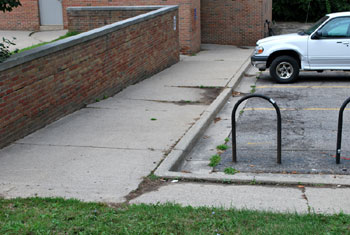
Ann Arbor Community Center sidewalk from front entrance down to entrance off parking lot. (Photo by the writer on Sept. 7, 2009; links to higher resolution file.)
-
Photos: University Townhouses
-

University Townhouses (Ward 3) entrance. (Photo by the writer on Sept. 7, 2009; links to higher resolution file.)




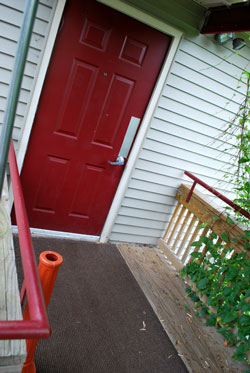
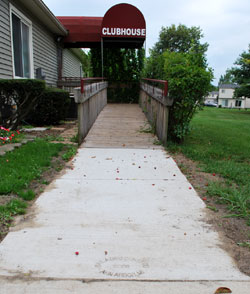
Thank you for this article. It just occurred to me–and I need to find this out–that I am not sure what the accommodations for the visually impaired or learning disabled are. I teach K-8, so I don’t see the high school kids, but I do know that a student with disabilities SHOULD get a Transition Plan in high school. One of the things on the transition plan is voting access. I presume that our high school teachers in my district (not in this county) are helping the kids with voting issues, but I don’t know.
I took the link to the September 1 letter and got an error message that it was not found. Below that error message were a series of lead paragraphs to various recent Chronicle stories – including what seems to be a *different* version of this story:
Pondering Ann Arbor Poll Accessibility
September 11 | A stern letter to the city of Ann Arbor from a nonprofit that advocates for accessibility provides a chance to reflect on the city’s polling places. The Chronicle takes a look at how the city ensures accessibility and why the kerfuffle reflected in the letter arose.
What’s the story here (so to speak)?
Re: [2] Thanks for the heads up about the broken link. The issue was not isolated to that document’s link alone. For reasons unclear to me, for all document links in the article, WordPress — at some point between Preview and Publish — seems to have trimmed out the domain name in the target, swapping out two dots (http://.. ) which should theoretically point to the next directory up, but somehow did not.
In any case, the links to the docs are fixed. Thanks for alerting us to that.
As for the other question about a different version of the first paragraph, what you saw was the “excerpt” of the article — not an alternate introduction. In our scheme these “excerpts” are supposed to be a short two-sentence synopsis, as opposed to a literal excerpt. What is the story with these “excerpts”?
On the home page, first four articles displayed in the center column include the first few paragraphs — whatever they are — down to the specified break point. But the next 30 or so articles appear with just their headlines and the “excerpt.”
These “excerpts” are also the summary text we use in the weekly email updates — those updates go out every Saturday to anyone who has signed up specifically for that.
Thanks!
I think “threshold” and “vestibule” problems mean that wheelchair users can’t get into the polling places by themselves. Dave, did you ask Beaudry what, if any, temporary solutions her people use for a wheelchair user who comes to the polls? For example, does an election worker assist such a person over the threshold? Or bring one of the portable voting stations out so that the voter need not enter the polling place at all?
If not, are these citizens simply unable to vote at all?
Many of the non-compliant door thresholds at the school buildings are currently being fixed or replaced by the schools. While the existing thresholds identified do not comply with the standards for polling place accessibility, I’m not aware of any instances where they actually prevented a voter from gaining access to a building. In some cases, a rug or mat can be placed over the threshold as a temporary solution.
We do not provide “curbside voting” as this is not approved by the Michigan Bureau of Elections. At several polling locations, we do have a “door bell” that a voter can ring for assistance.
What does it mean to provide parking at Slauson? Does that mean make accessibility improvements in the existing parking lot? Mark it better? Something else? Because there certainly isn’t any room to *add* parking…